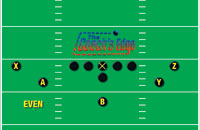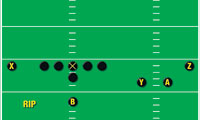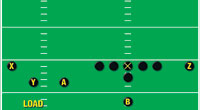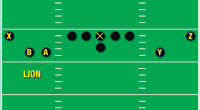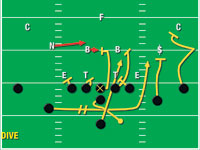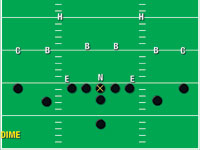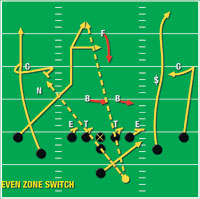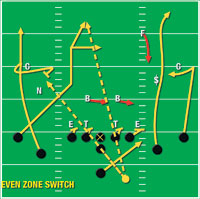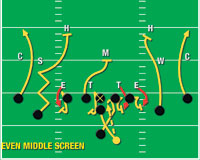Article CategoriesAFM Magazine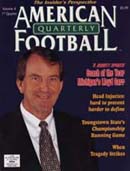
|
High-Flying HornetsNo TE, no FB- but a 2,000 yd.by: AFM Editorial Staff © More from this issue Emporia State University, an NCAA Division II school in the prestigious MIAA (Mid-America Intercollegiate Athletics Association) Conference, featured the most balanced, yet explosive offensive attack in all of college football. Utilizing an attack with four receivers, no tight ends or fullback, the Hornets established 42 ESU, 30 MIAA, and nine NCAA records. No tight end and no fullback. Wait a minute, is this the run-and-shoot? Hardly. To say that the Hornets have achieved these accomplishments by simply implementing the much maligned run-and-shoot offense would be a stretch. The ESU offensive scheme, known as the "Sting-and-Shoot", may be the system to take this somewhat radical brand of offensive football to the next step in its evolutionary process. Not since the inception of the Run-and-Shoot by Glenn "Tiger" Ellison, in 1954, has there really been a truly explosive, balanced attack using this type of personnel deployment. Yet, balance was not always the key to moving the ball for ESU. In 1995, Matsakis' first season, the Hornets threw the ball an MIAA record 623 times while rushing just 299 times. The Nation's Best Offense? Total Offense531.5 During the spring of 1996 the Hornets' offensive philosophy underwent a drastic paradigm shift. In a spring ball team meeting, head coach Manny Matsakis explained to the offensive personnel the importance of being able to rush the ball effectively, especially considering the fact that the Hornets were going to be young defensively that next fall, 8 freshmen were to start on defense. "We needed to keep our defense off of the field. We challenged the offensive personnel to not only lead the conference in total offense, but also do it with supreme balance by leading in both rushing and passing," explained Matsakis. In the fall of 1996, the ESU offense fulfilled its mission. The offense did just what they set out to do that spring: the average yield rushing was 274.4, passing 203.9. Each total led the MIAA that season. The Hornets utilized their superback (the scheme's name for the feature back in its one-back design), Brian Shay, for a staggering 2,103 yards rushing from scrimmage. The 1997 season brought it all together as the Hornets were able to put in place the nation's best offense that refused to punt*, and yielded an NCAA record for the highest average gain per play, 6.8 yards. *NCAA Record-Fewest punts per game 1.82, 20 punts in 11 games. (Breaks the old mark of 1.9 set by Kent in 1954.) The Rushing Attack ESU utilizes basically five formations along with a variety of motion by the inside receivers. In regards to game plans, the Hornets enter each game with 12-15 different series that translate into 35-40 different plays (See Diagrams 1-5).
Generally, the rushing attack is chosen from any of the following series: (1) inside traps; (2) outside traps/counters; (3 ) zone (inside and outside); (4) veer option; (5) dive/sweep; (6) load option, and (7) draws. Every rushing play is designed to be run at virtually every defensive front, with the exception of blitzing seven-man fronts. For instance, the Hornets stay away from running the Zone play into the blitz. Therefore, versus teams that utilize an extensive blitz package, the Hornets implement a game plan that automatically adjusts from the play called to any of six-to-eight possible blitz adjustments. These adjustments vary from utilizing another better suited run, or a quick pass that exploits a mismatch between one of the receivers and the opposing defensive back. Diagram 6 Diagram 7 The predominant plays out of the Hornet rushing package have been the Dive/Sweep series. (See Diagrams 6, 7). This series has allowed ESU's running back Brian Shay to embark upon one of the most remarkable careers in NCAA history.
The Passing Attack The passing attack utilizes a 90-degree soft roll by the quarterback and is designed to exploit the inherent weaknesses of nickel, dime and blitz coverages (Diagrams 8, 9, 10).
The Hornets generally go into a game with seven different pass schemes, as they have about a dozen from which to choose. Matsakis explained, "Our drop back philosophy is based on the saying; 'Read the coverage and take what they give you.' "The bread and butter drop back pass scheme is called Slide. Slide is the first scheme that we teach every year in training camp, it is sort of a rite of passage into our offensive philosophy as it embodies the versatility and ability to quickly adjust, inherent in our system (see Diagram 11).
"When we insert the slide scheme it is an exercise in total concentration and synergy. It begins with the motion of our inside receiver, aiding our personnel in getting a pre-snap read of the front/coverage combination," said Matsakis. "When the ball is snapped, the quarterback reads the flat defender as he rolls back to his launching point. Simultaneously, the superback adjusts to the front/coverage adjustments, while the receivers flow into the weak spots of the coverage. The key here is that by our third step into our scheme, the defense will have given up any possible disguise and at this point we must take advantage of any apparent weaknesses." The Hornets have had fantastic success in utilizing their play-action attack. One out of every two play passes attempted last year resulted in at least a 30-yard gain or a touchdown. "With teams gearing up for Brain Shay, we were able to take advantage of overaggressive safeties," said Matsakis. Kevin Keeffe, ESU's offensive coordinator, commented, "From a preparation standpoint, it is important we insert and practice 2-3 play-action passes each week triggered off our most featured run plays. The key to the play pass is to completely fool the linebackers and secondary by the upfield push of our offensive linemen and the backfield action. The combination will yield the types of results we strive for, explosive plays."
Exotics "Exotics" make up the balance of the Hornet offensive attack. These are off-tempo plays which utilize a run action or pass action to set up either a screen to the running back or to one of the receivers. Generally, one or more of the linemen will release down field to block a secondary or linebacker defender. The most successful exotic is the middle screen to the superback (See Diagram 13).
The middle screen yielded over 12 yards per attempt in 1977. Installation The Hornet staff initially installs the offense by assuming everybody knows the whole system, then they break it down into its individual facets, before finally building the offensive attack again piece-by-brick. This philosophy is regarded as a "Whole-part-whole" teaching method. Matsakis says it takes nine days to fully install the system and ESU does it in three, three-day cycles. "Day one stresses the whole offense versus the blitz, the protection, routes, and all schemes. Day two does the same versus nickel looks and Day three attacks dime defensive alignments. "We then take every detail fundamentally, and stress it versus the three basic defensive strategies. Day four versus the Blitz, Day five versus nickel and Day six versus dime. Finally, we come back and fully install the whole package for the next three days versus a combination of all looks. "By the tenth day of practice, we are ready to focus on any inherent weaknesses in our offensive attack, anything from fundamental skills to reading fronts and coverage schemes. "We continue to review and refine every aspect of the offense throughout the season, making sure not to ever let our players get rusty on any particular area of the attack. We do this in case we need to adjust the game plan at some point in a game. It has been much easier to do this, now that our players fully understand the system." Practice Format Emporia State squad size is limited, with only 55 men on the active roster. Therefore, they utilize a practice plan similar to that of NFL teams, with some interesting twists. The Hornets generally practice with uppers and only have controlled scrimmages in the spring. The tempo is quick as all plays are scripted by numbers on a master call sheet. During the practice week, Matsakis and his staff constantly simulate game conditions (game clock, etc.) Since the ESU squad operates out of a no-huddle scheme, each player wears wrist bands so he can decipher which play is being called. Plays are sent in from the sideline using a card and signal system. Wrist bands are color coded and contain 40 different plays. Matsakis has a call sheet designed the same as it is on game day, with situational attacks based on the schemes to be stressed that week. At any time the offense may break into an "Air Raid" which is a series of three to five scripted plays memorized by the players, helping to increase conditioning while maintaining supreme focus of all players on the field as well as any possible substitutions on the sideline.
Goals The Hornets' staff evaluates four areas of effectiveness to gauge their success on game day: first down efficiency, turnovers, explosives and green zone. First down efficiency is measured by the ability of the offense to run and throw well on first down. The key to attaining this goal on rushing attempts is for the offense to rush for plus four (+4) yards in over 50 percent of first down attempts. From a passing standpoint, the Hornets strive for a high percentage of completed passes, better than 60 percent. Turnovers are certainly a major determinant in the outcome of a game. Over the past three years when ESU has had a positive turnover ratio it has won 60 percent of the time. This is an interactive variable in that it has to do with the giveaway/take-away relationship of both offense and defense. Explosive plays were the key to winning in 1997 for ESU. The Hornets won 70 percent of their games when they generated two or more explosive plays than their opponent. "We put explosive plays into two categories, rushing and passing. A run of over 12 yards and a pass completion of over 16 yards is considered an explosive play," said Matsakis. In 1997, ESU produced 151 explosives (14 per game) as compared to 87 (eight per game) by its opponents. What many fans call the "Red Zone" is considered the "Green Zone" by ESU. While most teams consider this part of the field from the 20 yard line and in, ESU has expanded the area back to the 30 yard line. Furthermore, the coaching staff of the Hornets feels touchdowns are the truest measure for the offense so only count six-point scores towards "Green Zone" efficiency. "Basically, field goals are part of our kicking game goals. It is the job of the offensive personnel to get into the end zone and we shoot for a 70 percent touchdown scoring efficiency once we get to the 30 yard line," said Matsakis. In 1997, the Hornets converted 56 of 78 green zone possessions into touchdowns for an impressive 72 percent in touchdown efficiency. On the plains of Kansas, Manny Matsakis and his staff have unleashed an attack that has the potential to be more devastating to opposing defenses than the tornadoes that have made the state famous. With its lethal balance and quick strike ability, the ESU Sting-and-Shoot refuses to limit its carnage to a single incident of touching down, but rather touchdowns have been sited time after time after time. |
|
| HOME |
MAGAZINE |
SUBSCRIBE | ONLINE COLUMNISTS | COACHING VIDEOS |
Copyright 2024, AmericanFootballMonthly.com
All Rights Reserved


